COMMERCIAL FISHING IN JAPAN
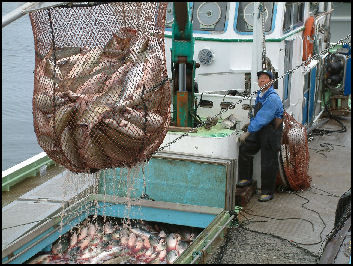
Japan is one of the world's largest consumers of marine products. It is the largest fish-eating nation in the world, consuming 7.5 billion kilograms of fish a year, or about 10 percent of the world's catch. This is the equivalent of 30 kilograms a year per person. Their nearest rivals the Scandinavians consume only around 15 kilograms per person. The Japanese consume so much fish that Japan has traditionally controlled the world prices for seafood with it huge demand.
Japan is home to a $14 billion commercial fishing industry. Fish and a variety of other sea creatures are caught by local fishermen, imported and raised in aqua farms. There are around 200,000 fishing vessels in Japan. Of these about 2,000 fish for tuna and bonito.
Sixty-six percent of the fish consumed in Japan is domestically caught. Even so Japan relies on imports for about half of its annual consumption of seafood, about 7.2 million tons in 2008.
Japan and China are the largest fishing nations. By some measures China has surpassed Japan in recent years but most of the fish that the Chinese consume are freshwater fish raised in fish farms. The Japanese eat mostly sea fish.
By other measures Japan is still the largest fishing nation. According to a National Geographic survey the largest harvesters of fish (metric tons) were: 1) Japan (7.5 million); 2) China (7 million); 3) Peru (6.7 million); 4) Chile (6.5 million); 5) Russia (5.2 million); 6) the U.S. (5 million).
Still the Japanese fishing industry is on the decline. Japan caught 12.8 million tons of fish in 1984 but only 6.35 million tons in 2000 and 5.52 million tons in 2002. In 2000, it imported 3.54 million tons of fish, double what it imported in 1984.
Fish consumption dropped around 15 percent in the 1990s, largely because of the time and difficulty in preparing it. The number of fishmongers in Tokyo declined 53 percent to 1,130 between 1980 and 2000.
Fish were traditionally used to fertilize rice fields and today symbolize the hope of an abundant harvest.
Websites and Resources
Links in this Website: FISHING IN JAPAN Factsanddetails.com/Japan ; BLUEFIN TUNA FISHING AND JAPAN Factsanddetails.com/Japan ; TSUKIJI FISH MARKET IN TOKYO Factsanddetails.com/Japan ; TRADITIONAL FISHING IN JAPAN Factsanddetails.com/Japan ; PEARLS AND JAPAN Factsanddetails.com/Japan ; SEAFOOD IN JAPAN Factsanddetails.com/Japan ; SUSHI Factsanddetails.com/Japan ; FUGU (BLOWFISH) IN JAPAN Factsanddetails.com/Japan ;
Good Websites and Sources on Fishing: Good Photos at Japan-Photo Archive japan-photo.de ; Ministry of Agriculture, Forestry and Fisheries maff.go.jp/e ; Statistical Handbook of Japan Fisheries Section stat.go.jp/english/data/handbook ; 2010 Edition stat.go.jp/english/data/nenkan ; News stat.go.jp
Good Websites and Sources on Blue Fin Tuna Fishing : Northern Blue Fin Tuna fishbase.org ; Southern Blue Fin Tuna fishbase.org ; Wikipedia article on Blue Fin Tuna Wikipedia ; Blue fin Tuna Fishing Methods content.cdlib.org ; Mediterranean Blue Fin Tuna Aquaculture eeuropeanrussianaffairs.suite101.com ; Southern Bluefin Tuna Aquaculture sardi.sa.gov.au/aquaculture ; Blue Fin Tuna Farming Off Spain uni-duesseldorf.de
Tsukiji Fish Market in Tokyo : Tsukiji Market site tsukiji-market.or.jp ; Essay on Tsukiji aboutjapan.japansociety.org ; Wikipedia Wikipedia ; Tsukiji Research people.fas.harvard.edu ; Japan Guide japan-guide.com Getting There: Best Japanese Sushi google.com/site/bestjapanesesushi ; Photos: Tsukiji Tour http://homepage3.nifty.com/tokyoworks/TsukijiTour/TsukijiTourEng.htm
Traditional Fishing in Japan: Ama Divers thingsasian.com ; Ama Physiology archive.rubicon-foundation.org ; Amasan hanamiweb.com ; Squid Fishing jtackle.info/squid ; Cormorant fishing Wikipedia article Wikipedia ; Cormorant fishing in Yangshuo yangshuo-travel-guide ; Photos of Cormorant fishing molon.de ; Articles on Cormorant Fishing highbeam.com
Globalization and Fish Imports in Japan
Growing global demand for fish is hurting Japan’s haul. Countries that used to catch large amounts of fish and export it to Japan are now keeping the fish for themselves.
Japan has become increasingly reliant on imported fish as fish stocks in its territorial waters have declined and the price of imported fish had dropped making it an attractive alternative to locally-caught fish.
Japan’s seafood self sufficiency rate has declined from a peak of 113 percent in 1964 to 59 percent in 2006. Tuna, salmon and shrimp are among the most widely consumed seafoods. They are mostly imported.
Worried about supplies and high prices, the Japanese government is urging people to eat more locally-caught fish to reduce Japan’s dependance on imported fish and especially encouraging people to eat seasonal fish’such as bonito in the spring, squid and saury the autumn and yellowtail snapper in the summer — whose catches are usually abundant.
Cheap imports has brought down the prices of many fish in Japan. The price of bigeye tuna is about ¥1,500 a kilogram, half of what it was in the 1980s, due mainly to cheap imports from Taiwan.
Fish Catches in Japan
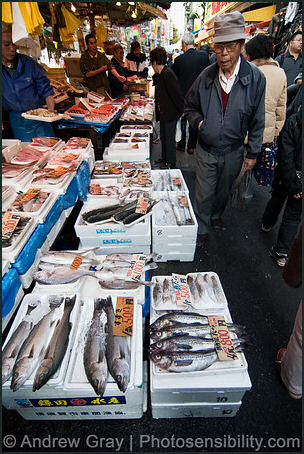
Fish stocks in Japan’s territorial waters are declining. Data shows that the stocks of 48 percent Of 90 categories of shore fish caught off Japan in 2007 have declined. Many fishing villages have go belly up and lost of the majority of their residents.
The catch of yellowtail snapper off Toyama Prefecture in winner of 2009-2010 was only one tenth of the catch in a usual year. Yellowtail caught cold water are favored because of their high fat content. Warmer sea waters were partly blamed for the low catch.
Top 5 most caught fishes (millions of tons per year): 1) Alaska Pollack (4.5); 2) Japanese Pilchard (4); 3) Chilean Pilchard (3.25); 4) Atlantic Cod (2.25); 5) Chilean Jack Mackerel.
Of all the fish caught in the world. Only about three quarters are eaten by humans. The remainder are used to make things like glue, soap, pet food and fertilizer.
Surmami, a protein past that is processed into seafood products such as fake crab, is made from pollack, a fish caught in huge nets large enough to swallow the Statue of Liberty and processed in huge floating factor trawlers
In 2007, trawlers based in Kesennuma Port in Miyagi Prefecture caught 34,900 tons of saury, the forth largest amount ever netted by a Japanese fleet. Fishermen sold the fish for around 40 cents a kilogram.
Japan’s Fishing Agency hopes to increase fish stocks by building 40-meter-high, 200-meter-long artificial underwater reefs from blocks made of coal ash and concrete to attract anchovies, horse mackerel.
Japanese Fish Industry
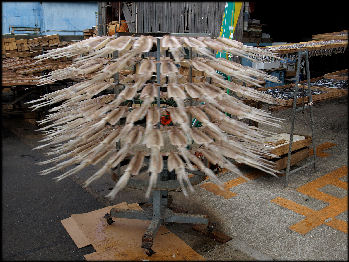
squid spinning The fish industry in Japan includes fishermen, traders, purchaser of fish, air shipping companies, trucking companies, butchers, packagers, delivery people. On its journey from the sea to customers plate, a single fish can change hands a dozen times, with each business taking a profit and adding an expense.
As Japan became more affluent in the 1980s the price of bluefin tuna soared. Worried that fisheries could be quickly overfished, regulators tried to impose quotas
The fishing industry has enormous political clout. They are strong supporters of the LDP, the political party that has ruled Japan during most of the post-war period.
Fishing vessels in Japan (1996): 354,000 in 2,950 fishing ports. Fishing employed 270,000 people in 1998, compared to 478,000 in 1978.
About 90 of the fishing on the open seas is done by vessels from Japan, Poland, Russia, South Korea, China, Spain and Fishing vessels from these countries range across all of the world oceans. They are sometimes found poaching in waters off Senegal, Argentina, Gambia, Ghana, Indonesia and the Philippines.
The Japanese use huge floating processor that not only catch the fish but package and freeze them for the Japanese market.
Problems in the Japanese Fishing Industry
Japanese Firms Move to Secure Fish at Home, Abroad
Daisuke Segawa wrote in the Yomiuri Shimbun: “Amid growing global demand for marine products, major Japanese trading companies are accelerating investments at home and abroad to secure a stable supply of such fish as salmon and tuna. Economic growth in China and other emerging countries where fish is commonly eaten is pushing fish consumption to ever higher levels worldwide. Meanwhile, many countries are discussing the need for limits on fishing of such popular fish as bluefin tuna to protect marine resources. [Source: Daisuke Segawa, Yomiuri Shimbun, February 27, 2012]
“In December 2011, Marubeni Corp. bought a U.S. marine product factory in Alaska for about 47 million dollars (about 3.6 billion yen). The factory procures and processes wild salmon and other fish. With the factory, Marubeni can supply 57,000 tons a year of marine products--mainly Alaskan salmon--to Japan, Europe and other parts of the world.In November, Mitsubishi Corp. purchased a Chilean salmon farming company, which has facilities capable of producing about 20,000 tons of salmon a year, at a total cost of about 125 million dollars (about 10 billion yen). Both companies have excellent business results and will be able to provide large quantities of fish to Japan. "Owning companies like this is just as valuable to us as owning promising mines or oil fields," a Marubeni official said.
“Major trading companies Sojitz Corp. and Toyota Tsusho Corp. farm bluefin tuna in Nagasaki Prefecture. Toyota Tsusho, which cultures bluefin from a juvenile stage, shipped about 13,500 fish to firms in Nagasaki and Kagoshima prefectures last year. The company said it utilizes farming sites where the sea is calm and employs Japan's advanced fish farming technology.
The fishing industry in Japan is facing many of the same problems as farming. A decline in incomes, empty towns and an aging work population. Suvendrini Kakuchi wrote in the Los Angeles Times, “Low counts of other fish, along with a dwindling, aging group of fishermen — the average age is now over 60 and their numbers are shrinking an average of 5 percent a year — have threatened the industry and the livelihoods of those who depend on it.” [Source: Suvendrini Kakuchi, Los Angeles Times, September 04, 2010]
“The Fisheries Agency of Japan said the market for domestic fish in 2008 dropped to $11.7 billion, down more than one-third from $18.8 billion a decade earlier, based on current exchange rates. The agency also has warned that half of the marine resources in the waters surrounding Japan have dropped drastically in the last two decades.
Overfishing and Global Warning and Japan
Overfishing is becoming a serious a problem in Japan. Overfishing in coastal areas has have depleted catches and caused fishing villages to shrink to edge of disappearing. Cod has been fished out in many places and salmon, saury, cuttlefish and crab are much scarcer than they used to be.
Suvendrini Kakuchi wrote in the Los Angeles Times, the Fisheries Agency of Japan “has warned that half of the marine resources in the waters surrounding Japan have dropped drastically in the last two decades. For example, less than 20,000 tons of horse mackerel, a fish widely eaten because of its affordable prices, is caught annually, down from 70,000 tons in 1991. And Pacific saury, a fall delicacy, is now fetching as much as $8 a fish — eight times as much as two years ago. The government agency attributed the low catches to rising sea temperatures that are affecting spawning and growth of fish and to overfishing.” [Source: Suvendrini Kakuchi, Los Angeles Times, September 04, 2010]
Overfishing is becoming such a problem that fish that have been traditionally been regarded unwanted are now big given a second look and turned into various food products. For example, small lizardfish, small horse mackerel, young yellowtail, deep-sea fish, dorado, Japanese butterfish and small blue mackerel, which in the past were thrown out, abr now being pressed into things like fish paste, fish sausages, skewered fish balls, and fish burgers.
Lower catches have led to an overwhelming dependency on expensive fish farms and imports, driving up costs.
Record hawls of shirasu whitebait caught off Fukushima Prefecture in the summer of 2010, the large catch was attributed to warmer waters associated with global warming. Other areas recorded lower than usual caches.
Salmon in Japan Catch Affected by Tsunami and Long-Term Decline
The Yomiuri Shimbun reported: “Iwate Prefecture's autumn salmon catch, known as the largest in Honshu, is down about 40 percent from autumn last year, it has been learned. Experts point to two major factors behind the sharp drop. One is damage to fixed salmon nets near the shore due to the March 11 tsunami caused by the Great East Japan Earthquake. The other is a continuous long-term decline in the number of salmon returning to the prefecture each year.It is likely the prefecture's total salmon haul for 2011 will fall below that of 2010, which was the lowest since hatching and releasing operations were launched in the prefecture in the mid-1970s. [Source: Yomiuri Shimbun, November 27, 2011]
“According to the prefectural government's Fisheries Industry Promotion Department, the number of salmon caught in the autumn salmon fishing season, which began in September, in 2011 reached about 647,000 as of Nov. 10, down 37 percent from the same period last year. By weight, the total haul up to November 10 2011 autumn was 1,856 tons, or 43 percent less than the corresponding period of 2010, the department said. Because much manpower was required to clear fishing grounds of debris and mend fishing equipment, only 72 of the prefecture's 116 stationary fishing nets were in operation officials said.
“Hauls of salmon in Hokkaido, which tops the list of prefectural catches of the fish throughout the country, also are reported to be poor for the second straight year. The lean catches of the two top salmon production centers have had an impact on prices of the fish and its roe, which are autumn and winter delicacies.
Reforming the Japanese Fishing Industry
Hiroyuki Matsuda, an eel resource researcher at Yokohama National University, told the Los Angeles Times there is no time to lose in instituting major changes to help the Japanese fishing industry survive, and the government needs to lead the way. "There must be a fundamental change in thinking," he said, pointing to the need for a fishing policy based on developing grass-roots-level sustainable fisheries. Takuhira Kaneko, head of Act For, a Fukuoka marine product wholesaler, agrees. "We need new policies from the government to help us protect resources that can even include cutting down on catches" over the long term, he said. [Source: Suvendrini Kakuchi, Los Angeles Times, September 04, 2010]
Seven years ago, Act For started the Mottainai fish project to buy fish discarded from those caught in nets and use them in such products as fish cakes. Mottainai, whose name means "stop wasting," accounted for $20,000 in sales last year and "helped us to face a business slump due to decreasing catches of popular fish," Kaneko said.
Wakao Hanaokoa, a tuna expert at environmental group Greenpeace Japan, has called on the government to develop a fishing management system to track endangered species "as a means of ensuring catches are from sustainable sources." Such a system, he told the Los Angeles Times would keep supplies limited and restrict the selling of endangered species, two important steps to protect them.”
Most fishing industry experts' say the that fish farming is the best solution for now.
Local government in some places are teaching students and teachers about fish caught in their areas and serving the fish in school lunches as part of an effort to help preserve fish-eating cultures peculiar to the areas. Among the fish being protected are flying fish and sailfin sandfish.
Resistance to Reforming the Fishing Industry in Japan
Japan’s resistance to seriously tackle the overfishing problem are manifested its reluctance to give up its controversial whaling program harvests about 1,000 whales a year. Tokyo justified the practice by saying the eating of whale meat is a tradition that must be protected. Japan also faced intense international pressure over fishing for young bluefin tuna in the Pacific, where its catches of 18,000 tons two years ago amounted to 90 percent of the total. At a March meeting of the Convention on International Trade in Endangered Species, the Japanese delegation fiercely opposed a proposed ban, which was defeated. Conservationists saw the effort as a means to protect the lucrative sushi market. [Source: Suvendrini Kakuchi, Los Angeles Times, September 04, 2010]
Akihiro Ono, a researcher at the Nihon Yoshoku newspaper, said Japan was trying to balance its responsibility to replenish fish stocks with its need to protect the nation's traditional marine-based diet. "The government hopes to continue with measures that will pave the way for sustainable fish catches. Accepting fishing bans is only the last resort," he said.
Fish Farming in Japan
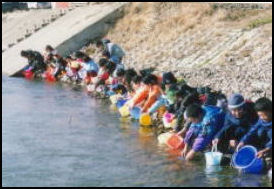
stockig salmon in Aomori Japan is one of the world’s top fish farming countries. Statistics show that the aquaculture industry produced ¥409.5 billion worth of marine products in 2009. The amount of fish raised on Japanese fish farms rose from 20.8 million tons in 1994 to 33.3 million tons in 1999. [Source: Suvendrini Kakuchi, Los Angeles Times, September 4, 2010]
Yellowtail, salmon, saurel, red sea bream and fugu (puffer fish) are the main fish raised in ocean fish farms in Japan. Sometimes they are fed tuna waste solids. Fishermen in various coastal regions raise various species, including white salmon, red sea bream and yellowtail. Hokkaido's industry produces products such as scallops, sea urchin and kelp. In Mie Prefecture, farms cultivate pearls and red sea bream while farms in Kochi Prefecture raise yellowtail and other marine products.New varieties being raised include filefish, masaba (a kind of mackerel), grunt, scorpionfish and gopher fish. Eels are raised in fresh water lakes.
Flounder have been successfully raised in swimming-pool-size tanks in Japan miles from the sea. Flounder are ideal for inland farming because they are profitable and they grow well in tanks because they don't move much. For other species the cost of building tanks is prohibitively expensive. A former construction industry manager has been able to harvest caviar from sturgeon he has grown from fry in tanks on the banks of a river in Agano in Saitama prefecture near Tokyo. Most of the caviar is served at his restaurant.
Carp farming is believed to have originated on the Yayoi period (400 B.C.-A.D. 300). The conclusion is based on the discovery of fossils of young carp teeth at an archeological site near Nagoya in what appears to have been a moat. Tsuneo Nakajima, the curator of the Lake Biwa Museum, which contains the fossils, told Kyodo, “The Yayoi may have released carp into rice fields, moats or ponds during the spawning season and the fish produced eggs. Primitive farming probably started in this way.” The young carp teeth were found in a different place than adult teeth. It is unlikely the two groups occurred in separation like this naturally and thus suggests fish farming. The technology for fish farming is believed to have been introduced from China along with rice farming,
Low Eel Catches and Eel Farms in Japan
Suvendrini Kakuchi wrote in the Los Angeles Times, “Dramatically lower eel catches from local river habitats have led to an overwhelming dependency on expensive fish farms and imports, forcing restaurants like Takayasu's out of business.” In 2009, “eelers caught 267 tons from natural habitats, a drop of two-thirds from the amount caught a decade earlier, according to the Nihon Yoshoku Shinbun, a publication that tracks marine resources. Last year's catch was less than 1 percent of the nearly 35,000 tons consumed; farming provided nearly 11,000 tons, and imports from China and Taiwan accounted for the remainder, the publication said.” [Source: Suvendrini Kakuchi, Los Angeles Times, September 4, 2010]
Industry experts have criticized the quality of imports as uneven and have noted that cultivating eels on about 300 fish farms nationwide is a high-risk, labor-intensive venture."The sad story of Japanese unagi is just one of the many examples of how Japan's voracious appetite for fish has created problems for itself," said Hiroyuki Matsuda, eel resource researcher at Yokohama National University.
Key progress was made in an aquaculture venture at Mie University that successfully raised eels from eggs, the first such experiment in the world. Still, it would take some time before growing eels from eggs could be turned into a commercial venture. Artificial feed and other expenses would make each eel cost thousands of dollars, experts said.
Michimasu Takayasu, fifth-generation restaurant owner, told the Los Angeles Times he worries about the growing expense. His Chuhei Co. is famous for the Bando taro variety of eel, a local species savored for its succulent meat but no longer found in local rivers. The eels are cultivated on expensive natural fish feed at two breeding farms in Japan, and annual harvests amounting to about 60 tons are sold to top restaurants in Tokyo. "Very soon, eating at special eel restaurants like ours might be only for the very rich," Takayasu said. "That's not going to do us any good."
See Unagi, Food, Life
Japanese Fishermen
 Less than 1 percent of the Japanese workforce make their living in fishing. Large fishing fleets have exhausted most of the fish supplies near the coast.
Less than 1 percent of the Japanese workforce make their living in fishing. Large fishing fleets have exhausted most of the fish supplies near the coast.
In many places fishermen are dependent on part time work linked with public work projects to make ends meet. A member of fisherman’s cooperative told the New York Times, "Historically, we are all dependant on the government and ruling party for handouts."
Fishermen routinely visit shrines to pray for safety. When a boat is launched it is given a special ceremony. Many towns have a Shinto shrine dedicated to Ebitsu, one of the seven lucky gods and the patron of fishermen. Prayers are said for good catches, good weather and safe passages at sea. Festivals feature fishermen carrying portable shrines with Ebitsu on them.
The Japanese have been fishermen for a long time. Six-thousand-year-old Jomon period sites have yielded fish hooks, net sinkers, spears and dugout canoes. Around 5,000 small fishing villages still freckle the coastline. This works out to about one for every four miles of coastline.
Tairobata — fishermen’s flags — used to be hoisted to announce bountiful catches. Now they are used mainly to launch ceremonies and festivals.
Japanese Fishing Villages

fishing festival In traditional fishing communities the vessels are mostly owner-operated. Some ships have enclosed cabins and inboard motors but most are just open skiffs with outboard motors. Concrete breakwater provide a safe anchorage for vessels in the community. Houses are packed around the cove.
Most coastal fishing is still done from small, owner-operated family vessels. Strict fishing rights laws prevent large vessels from working on inshore waters. Villages have the rights to harvest sea urchins, abalone, clams and spiny lobsters in waters adjacent to their communities.
Many Japanese fishermen are getting old. Many fishing towns are emptying and becoming ghost towns. Many local fishing industries are expected to close down when the last batch of fishermen retire.
Foreign Workers in Japanese Fishing
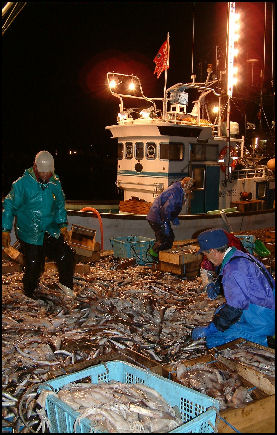
Japanese boats that spend long periods of time at sea rely on foreign workers, many of them from Indonesia. Many get paid less than the minimum wage for foreign workers of $375 a month. Sometimes they are paid considerably less than that. One Indonesian seaman told the Yomiuri Shimbun the most he was paid was $280 a month. “Sometimes, I’m only paid $150,” he said. Most are hired by brokers in their home country and presumably some of their pay goes to them.
Not only are foreign fishermen poorly paid, they also work like dogs. One told the Yomiuri Shimbun, “I slept only three to four hours a day. It was grueling work with no breaks. The toughest part was constantly being tossed about in a narrow cabin by waves for four to six weeks.”
Some of foreign workers come to Japan as trainees and are paid around $1,000 a month during their training period but their pay drops to between $300 to $700 a month, including overtime, when they start working as seamen. Many find the work to difficult and run away. Some flee their boats in Japan and find better paying jobs.
Japanese Fish Markets
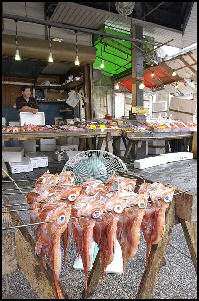
See Tsukiji Fish Market, Places, Tokyo
One fish merchant told the Yomiuri Shimbun, “I know how fatty a fish is just by looking at it...Fish which grow up in fast currents...have firm meat, because they swim hard, and they are tasty because they eat a lot...The knack to finding high-quality fish is to select vigorous ones because they have to stay alive overnight, or we can’t call them fresh.”
The fish markets are changing. With the depletion of fisheries around Japan and the changing of the fish distribution system, markets are selling less Japanese fish and more foreign fish, especially those caught on Chinese, Korean and Taiwanese vessels, or flow in from the United States, Australia, Mexico or Chile.
Most fish catches are placed in tanks or packed in ice and loaded from the fishing vessels directly onto trucks that carry them to Osaka and Tokyo and other destination during the night arriving at local fish markets in the morning. More and more fish are bypassing the fish auctions. Using refrigerated trucks outfit with tanks, fish can be delivered fresh almost anywhere in Japan.
Tuna
See Separate Article for Bluefin Tuna,
Crabs and Shrimp and Japan
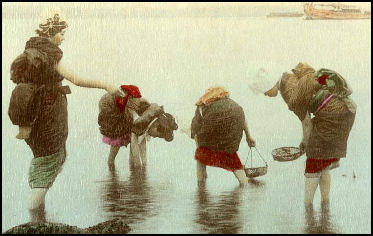
collecting shellfish in
the 19th century The Japanese love crab and regard it as a wintertime treat. Many places rely on crab to attract tourist in the winter.
Most of the crabs eaten in Japan are similar to the giant king crabs caught off Alaska. The crab catch season is from October or November to April or May. It used to be longer but has been shortened as a result of declining catches. One of the best crabbing areas is in the Japan Sea 50 to 100 kilometers off the coast of Kamicho, Hyogo Prefecture. Typically 38 tons of crabs are caught there per day, with the crabs selling fo ¥25,000 to ¥30,000 per 30 kilogram box at wholesale markets.
Fishermen in Ntosuke Bay fishing for Hokkaido shrimp still use traditional “utasebune” sail boats and trawl nets dropped from boats propelled by their triangular sails. The fishing is done from three dozen boats during a season that last for several weeks in June and July.
Shark Fin Factories in Japan
The are some shark fin factories in Japan. resumes operation/ Ones in Kesennuma, Miyagi Prefecture were devastated by the March 2011 earthquake and tsunami. A shark fin processor there resumed operations at a makeshift factory nearly four months after its original plant was devastated by the tsunami. At the new factory set up on higher ground employees steam shark fins using boilers taken from the damaged factory.
A large amount of bigeye tuna is consumed in Japan, mostly in the form of sashimi.
Image Sources: 1) JNTO, Ray Kinnane, Hector Garcia, xorsyst blog, Andrew Gray Photosensibility, Visualizing Culture, MIT Education
Text Sources: New York Times, Washington Post, Los Angeles Times, Daily Yomiuri, Times of London, Japan National Tourist Organization (JNTO), National Geographic, The New Yorker, Time, Newsweek, Reuters, AP, Lonely Planet Guides, Compton’s Encyclopedia and various books and other publications.
Last updated August 2012
